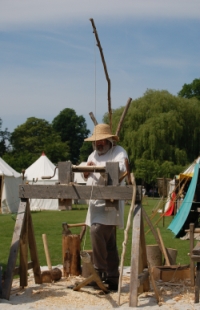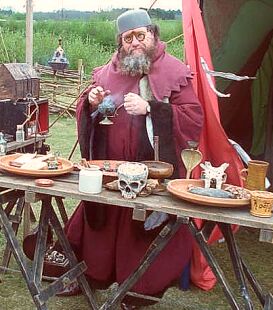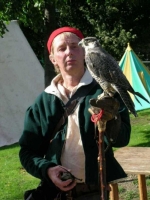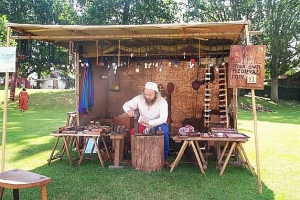The
Oyster fayre
Colchester’s first History
Fayre of the modern era took place in 1989, and commemorated the 800th
anniversary of the granting of
a Royal Charter to the
town in 1189. Since then our Medieval
Fayres have become a tradition,
and are now famous as
major public events in
the Eastern Counties.
The first Oyster Fayre,
an annual, event was in 2003.
This has now grown so
big that we feel that we can call it
The Colchester Medieval
Festival & Oyster Fayre.
Each June we will stage
a full medieval style fair,
with many of the peripheral
activities that this major annual event
of the period would have
offered. It remembers a time when folk
from the countryside and
neighbouring villages
would travel to the ‘Big
Fair’ in the town.
View
the Handbill
We set our fair in the
period 15th to 16th century.
We are not be able to
offer the traditional street fair in the town,
due to the limitations
of the High Street, so we
gather together on Lower
Castle Park all the colour and activities
of an historic, traditional
country fair that we can muster.
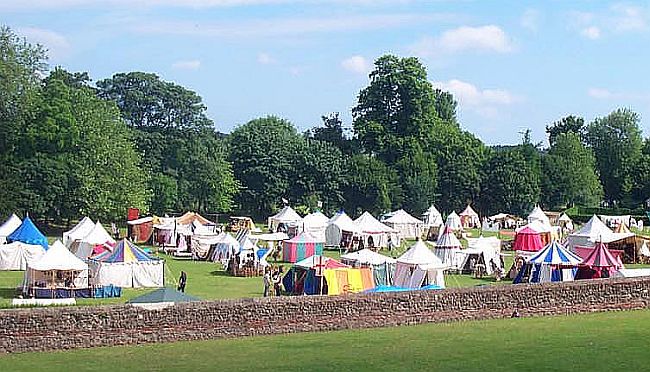
Crucial to such a past
gathering would have been the Market.
Here we show avenues of
stalls selling
anything from a pin to
a full suit of armour.
A great many pitches using
authentic tentage or booths.
Each trader will have been
carefully chosen, so that only true merchandise suitable for the traditional
market is provided. Maybe
a great wheel for spinning,
or linen for making clothes, new bowls for cooking, or leather to repair
shoes. All will be there and on sale.
Perishable goods such as
grain, fruit, vegetables and meat would normally have been purchased at
weekly markets, so should not
be expected at the Oyster
Fayre.
Of course no fair is complete
without side-shows.
We hope to have a good
variety of fair games for all to play,
some with prizes, so roll
up and ‘Splat the rat’.
At the Festival there will
be no display of
massed troops, but instead,
a tourney ring or combat area.
Here we can stage hand-to-hand
armed combat,
demonstrating the use
of various weapons and armour,
with a referee to ensure
that things don't get out of hand.
Visitors will have the
opportunity to try on armour
and feel the weapons,
such as bill and poleaxe, at first hand.
The true weight of a mail
shirt never ceases to amaze the public.
Everyone went to the fair,
and let's face it, there were not many other opportunities for entertainment
and socializing in those meaner times. So, expect to see some strange fellows
or hear unfamiliar cries,
a wandering trader
may ask you to stand awhile as he shows his wares or tells a tale or two.
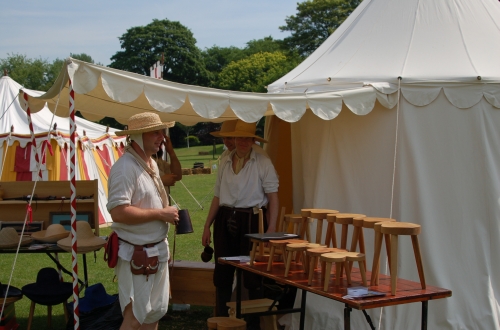
Dance and drama would have
been popular entertainment at fairs.
The public will be invited
to participate in the simpler dances,
with instruction in the
trickier ones available. An area for players will be assigned where Mummers
can perform their plays. There will be other performing areas where individuals
can story-tell
or recite poems, and players
can show dramatic interludes.
Here again we may have
singers, jugglers, tumblers and stilt walkers.
For the young ones, and
the young at heart, there will be
puppet masters plying
their trade, and, I dare say,
shaking a hat for a grote
or two.
Archery was all-important.
Until the middle of the C16th it was
the main weapon of combat
and also of sport. All men of fighting age were expected to practice at
the butts, once a week, usually after church on Sunday. So a ‘close’ will
be set up, with butts for practice
and competition. Here
again the public will have the opportunity
to ‘have a go’. Demonstrators
and instructors will be on hand
to ensure a safe representation
of this aspect of medieval life.
Skilled archers, from far
and wide, will be invited to take part in
a Costumed competition.
This will feature various targets throughout the grounds, in areas of increasing
difficulty,
including river shoots,
mock animals, hanging and purse targets.
‘Archer of the Fayre’
will be their reward, and also a prize or two.
Archery was the sport for
the common man, whilst Falconry
was that of the Gentry
classes. We will endeavour to display
this side of medieval
life too, by the flying of hawks in the arena.
Not only will there be
two flying demonstrations a day,
but the birds will be
on show in the hunting Pavilion,
for all to view and maybe
even handle.

No fair is complete without
those who have travelled miles to be there. We will see many costumed individuals
mingling with the C 21st public at the stalls and side shows. Some will
be invited, some will come out of interest or to buy those vital pieces
of kit, and we expect
that a few locals may
even wish to dress up.
We will also invite re-enactors,
who specialize in
Living History, to set
up small encampments and go about their
daily routine.
Certainly outsiders would
have slept in their carts
and stalls, and a bustling
community of travellers and traders
would have established
its camp for the duration of the fair.
Some will be cooking,
some gaming, and some just practising good old creative idleness. Some
tents will be open for the curious to inspect, but remember to keep your
hands to yourself lest you be caught by the Fayre Constable or his patrolling
Henchmen.
Tradesmen and demonstrators
will be on hand. Adjacent to their market stalls they can show their art
and skills in industries such as pottery, spinning, rope-making, candle
dipping, tailoring, sword making, fletching and bow making, to name but
a few. Maybe the public will be able to buy from the artisans, or just
marvel at their dexterity.
To service such a productive
and consuming fair, we will require food, drink and supplies ‘many and
various’. We will also have set up
a tented tavern, where
fine ales and mead can be purchased
by all attending the fair.
Food must needs be available,
and we shall of course have to resign ourselves to modern standards of
presentation at the fair, but we will attempt to conceal what would be
otherwise anachronistic.
We shall have plenty of
modern food outlets for the visitors' pleasure outside the fair perimeter,
but cooking will be on show
and maybe pie and biscot
sellers roaming. And or course Oysters.
Finally, to feed the soul,
lots of music. Strolling musicians and players will always be in evidence.
Be it loud or soft, you will never be far from the pipe or drum.
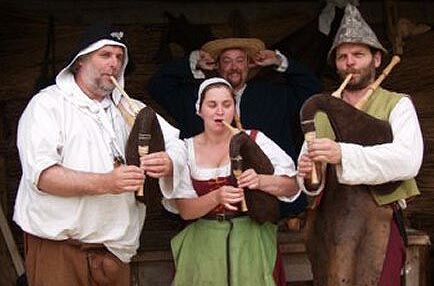
The Grand Opening and Closing
of the fair and the awarding of prizes
will also take place near
the Arena. The Mayor will of course
open the Fair, and his
Insignia, a decorated Hawking Gauntlet, will
be kept by the Grand Marshal
of the Fayre ‘till trading be done’.
We hope that the fair will
attract re-enactors from far and wide, not only wanting to participate
in this unique experiment, but also just visiting and adding to the colour
and atmosphere. Maybe they will purchase treasured items not seen elsewhere,
or just say ‘I was at Colchester’. Visitore regularly come from across
the UK and near Continent.
Here is an opportunity
to bring together the best historical interpreters, & medieval artisans
to probably the best fair and market anywhere in Britain. Help to make
it a special.
Join us in June and you
too can be part of this exciting event:
The
annual Colchester Oyster fayre
Elements of the Fayre may change or be
added to without prior notice.
Back
to the Bill of Fayre

